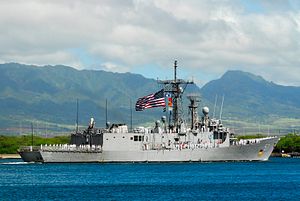Where are debates on the future of fleet composition and naval force development headed? So far, discourse has been dominated by carrier battle groups. It’s not going to stay that way for long.
The utility of sea control has always been measured by its capability to influence events on the shore. Aircraft carriers are naturally attractive to the United States and China as they can help attain sea control visibly and directly. Deriving their offensive power from their air wings, aircraft carriers can strike deep into the enemy’s homeland. Unlike submarines, carriers offer unmatched flexibility and lethality coupled with the ability to be as intrusive or as subtle as desired. The carrier’s ability to rapidly adapt its air wing to almost any expected threat is a tremendous advantage. Carrier groups can also be used as a diplomatic tool as well, influencing enemy behavior by providing air support in situations where there are no land-based options. That’s why aircraft carriers are so appealing to policymakers. Sounds quite impressive and yet why is it that carriers have limited appeal when questions of littoral sea control and power projection are concerned?
While ground, air, and other naval forces contribute to sea control in a wide variety of situations, their primary orientation and utility lies in power projection. Surface warfare combatants (SWC) are the only combatants capable of conducting the full range of sea control missions as their primary task. In fulfilling this first role, SWCs take on anti-submarine warfare, anti-surface warfare, anti-air warfare, and mine warfare missions. This is crucial as it allows other power projection platforms, such as amphibious units and aircraft carriers, to fulfill their missions.
Another advantage of SWCs is their offensive capabilities which represent an extension of their support roles. These capabilities have proven especially useful to the U.S. Navy as it attempts to gain access to contested commons in the face of Chinese anti-access and area denial systems (A2/AD). U.S. naval power today is concentrated around its aircraft carriers. This creates a vulnerability as their elimination irrevocably dents America’s naval striking power. The U.S. Navy’s endorsement of the concept of “distributed lethality” in response to this dilemma has generated a flood of commentary. James Holmes over at War on the Rocks encapsulated the concept well: “Disperse firepower among surface warships, making every vessel a combatant. Disperse the fleet into compact surface action groups. Disperse surface action groups across embattled theatres.” Disaggregating naval forces into smaller ‘Surface Action Groups’ with independent offensive capabilities “spreads out the playing field,” ensuring a targeting dilemma is created for A2/AD forces. In such an eventuality, simply crippling American aircraft carriers will not render the broader fleet incapable of fulfilling its missions.
Another important role played by the surface warfare combatant relates to its defensive role in ballistic missile defence (BMD). The BMD-capable Aegis fleet is scheduled to grow from 33 to 43 by the end of 2019. From Europe to the Asia-Pacific, demand for these BMD-capable ships far exceeds supply. That only reinforces Navy Rear Admiral Jim Kilby’s notion that surface warfare forces are the lynchpin of integrated air and missile defense.
SWCs offer immense flexibility across the spectrum of operations. Their contributions range beyond merely sea control as they are more than capable of pulling their weight in deterrence, power projection, and maritime security missions too. By the sheer virtue of their numbers SWCs can also provide value in operations during peacetime. The international arena is today characterized by the diffusion of power and an increased risk of conflict which is more likely to manifest itself in the form of irregular warfare. The forward presence that numerous SWCs can provide around-the-clock is going to make them the ideal platform for navies in coming years.
The future of the surface warfare community is indeed looking quite bright.
Himanil Raina is a B.A LL.B (Hons) student at the NALSAR University of Law and a freelance writer on geopolitical and international affairs.

































